Smart glasses are a peculiar segment of wearable tech. Unlike other slightly more established niches—wristbands that support fitness or health; smartwatches that channel smartphone notifications to the wrist—connected eyewear hasn’t quite found its killer feature yet.
Not that companies aren’t trying. Of course, there are the big names like Google Glass, with its lightweight, untethered camera and tiny “monocle” screen, and virtual-reality goggles maker (and recent Facebook acquisition) Oculus Rift. Somewhere in between lie far less well-known augmented reality purveyors like Vuzix, newcomer Meta and many others.
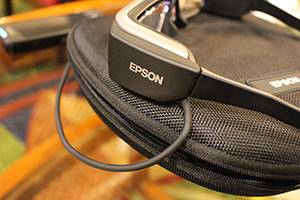
I recently met up with one of these middle-tier aspirants, and a particularly unlikely one at that: Epson. Most people know the company for its home inkjet printers, although it also makes business and home-entertainment projectors. As it turns out, the latter technology turned out to be surprisingly adaptable—so much so that Epson built it into a set of augmented reality glasses it calls Moverio.
Epson launched the first Moverio in 2012, to no particular acclaim. It’s just followed up with a second generation version, the catchily named BT-200. I happened across Moverio at a tech conference last week, and couldn’t resist the opportunity to have my reality augmented—by a printer company, no less.
How Do You Take Your Reality?
Virtual reality aims to take the user entirely out of their immediate surroundings in order to immerse them in a digital environment—one that might look a lot like real life, or nothing at all like it. Augmented reality, by contrast, doesn’t replace the world around us; instead, the goal is to enhance our experience of the physical world.
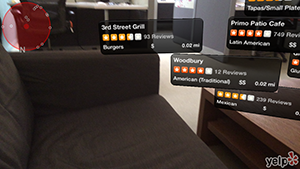
There may be augmented-reality features in your smartphone already, whether you know it or not. The Yelp mobile app, for example, offers a “monocle” feature that displays nearby Yelp-reviewed locations as you hold up your phone and pan it around.
An augmented reality headset takes the phone out of the equation by displaying an informational overlay in the user’s field of vision. And it does so without the queasiness that virtual reality goggles can trigger. At least, that was my experience with Moverio.
Before I could even ask, Anna Jen, Epson’s director of new ventures and new products, said, “You must be wondering why Epson’s involved with wearables, huh?” I was, indeed.
It all comes back to those projectors, since Moverio is basically just two tiny projectors lodged inside an eyeglass frame. They transmit light to a mirror that bounces the image to two sets of prismatic lenses. End result: Both eyes view the augmented image. That’s something products like Google Glass and the lesser known Vuzix M-100, in all their monocled glory, can’t offer.
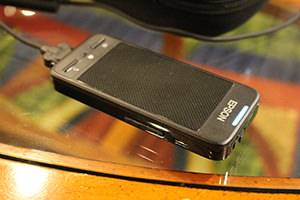
Through the glasses, I could still see the hotel registration desk in front of me, about fifty feet away. In front of me, I also saw a translucent virtual “screen” hanging in mid-air. It didn’t fill up my whole vision—it only has a 23-degree field of view. But it’s conical, which means that the further away you look, the larger the window appears. Focus on something closer, and the window seems smaller.
I recognized the virtual screen immediately—it was an Android homescreen. The outer-space themed wallpaper inside the window panned and tilted right along as I looked around, thanks to a motion-tracking gyroscope that tracked my head movement.
The glasses feature a front-facing camera and detachable earphone. With 960×540 resolution, it can display 2D or 3D graphics in the center or sides of the viewable frame. It comes with a corded Android 4.0 controller about the size of a smartphone that features a textured trackpad where the touchscreen would normally be. To interact with what you’re seeing, you swipe or tap the box. It also comes with Wi-Fi, Bluetooth and 4GB microSDHC storage, with an expansion slot for an additional 32GB.
In this world of wireless everything, the cabled box felt clumsy and old-fashioned. But it’s a trade-off. The cord actually helps optimize battery power—up to five or six hours (two to three, if the controller is connected to WiFi). It also enables data to flow quickly and reliably between the box and my facegear. As I looked around, the world inside that window moved with me in real time.
Real Reality—But Better
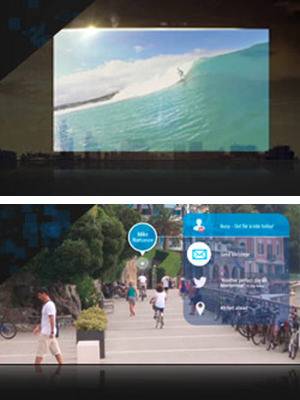
Epson likes to say that watching online videos with Moverio is like having an enormous, big-screen TV for your own personal use. And in fact, the Moverio is like a heads-up display on steroids, one that’s capable of 2D or 3D graphics. So users could just use it as a display for mundane activities, like watching online videos, surfing the Web, playing games or checking emails. In fact, they could download and use any Android 4.0 apps from the Amazon App Store, like Netflix and Angry Birds.
But that only scratches the surface. Epson’s Jen says that developing for Moverio isn’t any more difficult than building a mobile app. That could unlock uses for entertainment, gaming and other consumer applications, but Epson thinks it could have an even bigger impact on big organizations. That’s why Epson has been courting companies, developers and early adopters.
Doctors could benefit from a visual overlay that illustrates steps in a tricky surgery, Jen explained. Warehouse workers with their hands full could just look at key points in the production line for real-time updates on the pipeline. Museums can loan headsets out to visitors to provide contextual pop-ups as they wander through exhibits. These aren’t simply theoretical situations—they’re are actual projects that Epson is working on with developers like APX Labs and Metaio.
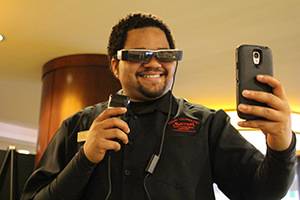
Don’t just take my word for all this. As I was speaking with Jen at the conference, a curious hotel worker named Travon came up to us. He’s an early adopter, for sure—he’d ordered Google Glass but at the time hadn’t yet received it—and he couldn’t help himself once he saw the glasses in front of us. Jen let him take Moverio for a whirl, and he was blown away by what he saw—so much so that he selfied the moment immediately.
Moverio costs $699, or a little less than half what you’d pony up for Google Glass. In hopes of appealing to developers and early adopters, Epson is selling the new model on its website and at PreLaunch.
The New Reality
Compared to the competition, Moverio offers a lot for the money. That twin-lens, 23-degree field of view is pretty significant; the greater the breadth of view, the more immersive the experience.
Google Glass, by contrast, offers a 14-degree monocular field of view for $1,500. Vuzix M-100, another monocle, has a 15-degree field of view and a $1,000 price tag. Meta, which dubs its line of products “SpaceGlasses,” offers a striking 40-degree field of view (one that apparently can make you feel like a “real-life Tony Stark“). But you’ll pay for that. When its upcoming MetaPro glasses ships later this year, they’ll set you back $3,000.
Of course, some of the higher prices may reflect the cost of aesthetic design. These are, after all, gadgets intended for wear on your face. The MetaPro looks like aviator sunglasses. Google Glass and Vuzix both distinctly resemble like a Terminator-style head mount. As for Epson—well, it’s not exactly a stylish piece of kit. But for what it does, there’s no question that it’s a bargain.
Prices are sure to drop further as component costs come down. That could be the reality that, well, augmented reality has been waiting for. Of course, that could usher in some interesting new possibilities—like CastAR from Technical Illusions. The upstart, formed by ex-Valve engineers, wants to merge augmented and virtual reality into a single set of glasses. The kicker? The starting price is just $194.
The reigning virtual-reality champion—if you can say that about a product that hasn’t even launched yet—Oculus Rift hasn’t been sitting still. The team just scored a major win, bringing Google Glass engineer Adrian Wong into the fold. Google, of course, has been busy as well. On the hardware front, Google just made Glass available for anyone to purchase (finally), while on the software side, the company pursued plans to beef up Google Translate by acquiring Quest Visual and its augmented reality app Word Lens Translator.
It’s an exciting time. When the dust settles, and prices level out to mere mortal levels, we could find ourselves with an entirely new way of interacting with the technologies that drive our work and our play. And at that point, reality as we know it may never be the same.










